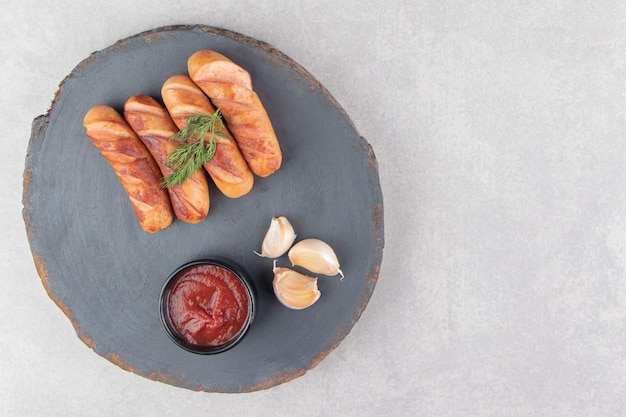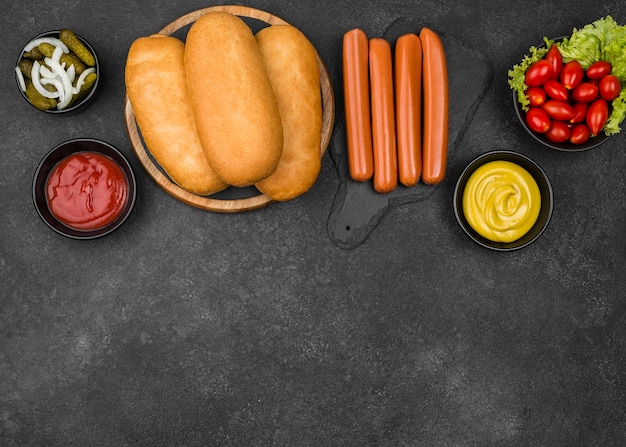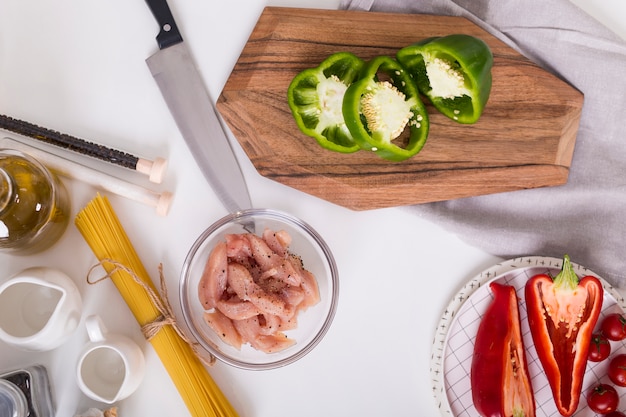Ah, breakfast sausage. The aroma alone is enough to get your taste buds tingling, isn't it? It's a British breakfast staple that conjures up images of lazy weekend mornings and hearty, satisfying meals. But achieving that perfect crispy, juicy sausage isn't always a walk in the park. I've certainly had my fair share of breakfast sausage disasters – burnt ones, undercooked ones, you name it! But I've learned a thing or two over the years, and I'm here to share my secrets, so you can avoid those sausage mishaps and become a breakfast sausage master yourself.
(Part 1) Choosing the Right Sausage

The Great Sausage Debate: Pork, Chicken, or Something Else?
First things first, you need to decide what kind of sausage is calling your name. The classic pork sausage is always a safe bet, with its rich, meaty flavour. But there are so many other delicious options out there. Chicken sausage offers a lighter, more delicate taste, perfect for those looking for a healthier breakfast. Veggie sausages are a fantastic way to add some plant-based protein and can be incredibly versatile. And if you're feeling adventurous, you can even find sausages made from venison, lamb, or even exotic meats.
Personally, I'm a huge fan of good old-fashioned pork sausage. It's just got that irresistible flavour that screams "breakfast" to me. But I encourage you to step outside your comfort zone and try something new! You might discover a new favourite.
The Importance of Freshness
Once you've chosen your sausage type, it's time to make sure it's top-notch. I always check the "use by" date and give the packaging a good look over to make sure it's not damaged. You want those sausages to be fresh and vibrant, not limp and pale! If you can, buying your sausages from a local butcher is a fantastic option. You'll get better quality, and you'll be supporting your community. Plus, they often offer a wider selection of flavours, like Cumberland sausage, with its slightly sweet and peppery taste, which is a personal favourite.
(Part 2) Prepping Your Sausage

The Art of the Pat
Alright, you've got your sausages, now what? Before you even think about cooking, give them a gentle pat with some kitchen paper. This removes any excess moisture, which helps to prevent steaming and encourages those sausages to develop a lovely crispy skin. It's a simple step, but it makes a big difference in the final result. Trust me, I've learned the hard way that soggy sausages are a big no-no!
Should You Prick Them or Not?
This is a topic that sparks endless debate, much like the pineapple on pizza debate, I know! Some people swear by pricking their sausages with a fork before cooking to prevent them from bursting, while others say it's unnecessary. I'm somewhere in the middle. I usually prick my sausages a few times, especially if they're thicker, just to help them cook more evenly and prevent any surprises. But if you're using thinner sausages, you can probably skip this step.
Beyond the Basic: Flavouring Your Sausage
Now, this is where things get fun! Adding a little extra flavour to your sausages before cooking can elevate them from good to amazing. My personal go-to is a simple dusting of smoked paprika. It adds a lovely smoky aroma and a hint of spice, without overpowering the sausage's natural flavour. But you can experiment with other herbs and spices, like rosemary, thyme, or garlic powder. Just be sure to use them sparingly, you don't want to mask the delicious sausage flavour. I've also been known to add a pinch of chilli flakes for a little kick, which works surprisingly well!
(Part 3) The Cooking Methods: Pan-Frying, Grilling, and More

The Classic Pan-Frying Method
Right, let's talk about the most common and arguably the most effective method – pan-frying. It's a quick and easy way to cook sausages, and it delivers those perfect crispy results we all love. Just heat some oil in a non-stick pan over medium heat. You want the oil to be shimmering, not smoking. Once it's hot, carefully add your sausages to the pan, making sure not to overcrowd it. You want them to have room to cook evenly, so they don't steam and become soggy.
Now, here's the key – resist the urge to flip them constantly! Let them cook undisturbed for about 3-4 minutes per side, or until they’re golden brown and starting to crisp up. You can turn them once or twice to ensure even cooking, but be gentle! And don't forget to baste them with the rendered fat, that delicious golden goodness that drips out of the sausage as it cooks. It adds so much flavour! If you’re short on time, you can also cook your sausages in a cast iron skillet – they come out beautifully crispy.
Grilling for That Smoky Flavour
For a truly delicious, smoky flavour, try grilling your sausages. Preheat your grill to medium-high heat and give it a good scrub to make sure it's clean. A dirty grill will leave you with burnt bits sticking to your sausages, which isn't ideal. Place your sausages on the grill and cook for about 5-6 minutes per side, or until they’re cooked through. To enhance that smoky flavour, you can soak some wood chips in water for about 30 minutes and add them to the grill during cooking. Just be careful not to overcrowd the grill, you want the sausages to have enough space to cook properly.
Other Methods: Baking, Roasting, and Air Frying
If you’re looking for a healthier option, you can bake your sausages in the oven. Preheat your oven to 375 degrees Fahrenheit (190 degrees Celsius) and place your sausages on a baking sheet lined with parchment paper. Bake for about 20-25 minutes, or until they’re cooked through.
You can also roast your sausages in the oven, which is a great way to cook multiple sausages at once. Preheat your oven to 400 degrees Fahrenheit (200 degrees Celsius). Spread your sausages out on a baking sheet, add a little oil or butter, and roast for about 20-25 minutes, or until they are cooked through.
Lastly, you can use an air fryer to cook your sausages. Preheat your air fryer to 400 degrees Fahrenheit (200 degrees Celsius), place your sausages in the basket, and cook for about 8-10 minutes, or until they’re cooked through. This method can get a little messy, as the sausages tend to release some fat, so make sure to line the basket with parchment paper.
(Part 4) How to Tell If Your Sausage is Cooked
The internal temperature Test
This is the most reliable way to check if your sausage is cooked through. Use a meat thermometer and insert it into the thickest part of the sausage. The internal temperature should be at least 160 degrees Fahrenheit (71 degrees Celsius). If the temperature is lower, cook the sausages for a few more minutes.
The Visual Inspection
If you don’t have a meat thermometer, you can also check the sausage by its appearance. The sausage should be firm to the touch, and the colour should be evenly browned. If the sausage is still pink in the middle, it needs to be cooked for longer.
The Squeeze Test
Another helpful way to check for doneness is to gently squeeze the sausage. If the sausage feels firm and springy, it's cooked through. If it feels soft and squishy, it needs to be cooked for longer.
(Part 5) Serving Up Your Breakfast Sausage
The Classic Full English
Of course, no discussion of breakfast sausage is complete without mentioning the iconic Full English breakfast. It's a true British classic! Serve your sausage alongside bacon, fried eggs, grilled tomatoes, mushrooms, beans, and toast. You can even add a black pudding for a truly authentic experience.
Beyond the Traditional
But the possibilities are truly endless! Try serving your sausage with a side of pancakes, waffles, or even a simple salad for a lighter option. You can also add them to a breakfast burrito, a breakfast sandwich, or a breakfast hash. Get creative and experiment with different combinations! I've even added sausage to my breakfast omelettes, it adds a nice salty flavour to the eggs.
The Importance of Sauces and Condiments
Don’t forget the sauces and condiments! A good dollop of HP Sauce is a classic pairing for breakfast sausage. You can also use mustard, ketchup, or even a homemade hot sauce. Personally, I like to drizzle a little maple syrup on my sausages, it adds a sweet and salty flavour combination that I absolutely love.
(Part 6) Leftovers: Storage and Reheating
If you have any leftover sausage, don't worry, you can use them in a variety of dishes. Just store the cooked sausage in an airtight container in the refrigerator for up to 3 days. When you’re ready to eat, you can reheat them in the microwave, oven, or pan.
For a quick and easy meal, try reheating your sausages in a skillet with some diced onions and peppers. You can add a splash of water to create a delicious pan sauce. Or, you can use your leftover sausage to make a hearty breakfast casserole. Just combine the sausage with eggs, cheese, and your favourite veggies, and bake until it’s set.
(Part 7) Tips and Tricks from a Sausage Master
The Power of the Pan
I always use a cast iron skillet for cooking my sausages. It heats up evenly and produces a beautiful crispy crust. But if you don’t have a cast iron skillet, a good quality non-stick pan will do the trick.
Don't Overcrowd the Pan
Give your sausages plenty of space to cook evenly. If you crowd the pan, they’ll steam instead of crisp up.
Baste, Baste, Baste!
Baste your sausages with the rendered fat for extra flavour. It’s a simple step, but it makes a big difference.
Use the Right Oil
I like to use a neutral oil with a high smoke point, like avocado oil or grapeseed oil. They won’t add any unwanted flavour to your sausages.
(Part 8) FAQs
1. Can I cook breakfast sausage in the microwave?
While it is technically possible to cook breakfast sausage in the microwave, I strongly advise against it. Microwaving can lead to uneven cooking, leaving some parts raw and others overcooked. The texture will also be far from the crispy, juicy sausage we all crave. For the best results, always opt for pan-frying, grilling, baking, or roasting.
2. How do I prevent sausages from bursting while cooking?
Pricking the sausages with a fork before cooking is a common technique to prevent bursting. It allows the steam to escape, making them less likely to explode in the pan. However, if you prefer not to prick them, be sure to cook them over medium heat and avoid overcrowding the pan. This will ensure they cook evenly and reduce the risk of bursting.
3. How do I know if my sausages are undercooked?
The easiest way to check for doneness is with a meat thermometer. Insert it into the thickest part of the sausage, and it should read at least 160 degrees Fahrenheit (71 degrees Celsius). If you don't have a thermometer, look for a firm texture and an even, browned exterior. If the sausage is still pink in the middle, it needs to be cooked for longer.
4. Can I freeze breakfast sausage?
Yes, you can freeze uncooked breakfast sausage. Wrap them tightly in plastic wrap or foil, and then place them in a freezer-safe bag. They should last for up to 3 months in the freezer. To cook frozen sausage, simply add them directly to the pan without thawing. They will take a little longer to cook, so adjust the cooking time accordingly.
5. What are some creative ways to use leftover breakfast sausage?
Leftover sausage is a culinary treasure! Here are a few ideas:
- Add it to a breakfast hash with potatoes, onions, and peppers.
- Combine it with scrambled eggs, cheese, and your favorite veggies for a quick and easy breakfast casserole.
- Crumble it into a salad for a protein boost and savory flavor.
- Use it as a topping for pizza or baked potatoes.
- Add it to a hearty soup or stew for extra flavor and texture.
(Part 9) A Sausage Master's Final Thoughts
Well, there you have it! My ultimate guide to cooking delicious breakfast sausage. Remember, it’s all about choosing the right sausage, prepping it carefully, and using the best cooking method for your needs. And don't be afraid to experiment with different flavors and serving ideas! The possibilities are endless, and your taste buds will thank you for it. Now go forth and conquer the breakfast sausage world!
Oh, and one last tip: don’t forget to enjoy the process! Cooking is an art form, so relax, have fun, and let your inner sausage master shine!
Everyone is watching

Corn on the Cob: The Ultimate Guide to Perfectly Cooked Ears
Healthy MealsAh, corn on the cob. Just the name evokes images of sunny days, barbecues, and that sweet, juicy flavour that ...

Scallops: The Ultimate Guide to Perfect Cooking
Healthy MealsAh, scallops. Those delicate, sweet, and utterly delicious morsels of the sea. They hold a special place in my...

Spaghetti Squash: The Ultimate Guide to Cooking and Serving
Healthy MealsRemember that time you saw spaghetti squash at the supermarket, looking all bumpy and strange, and thought, "W...

Salmon Cooking Times: Perfect Guide for Every Recipe
Healthy MealsLet me tell you, cooking salmon is an art form. It's all about getting that perfect balance: juicy and tender,...

Ham Cooking Time: How Long to Bake, Smoke, or Boil a Delicious Ham
Healthy MealsAh, ham. It's a classic, isn't it? A real crowd-pleaser, especially around holidays. And when done right, it'...
